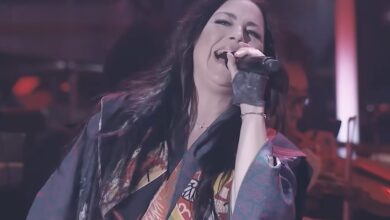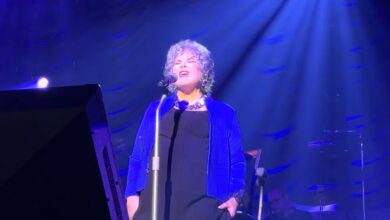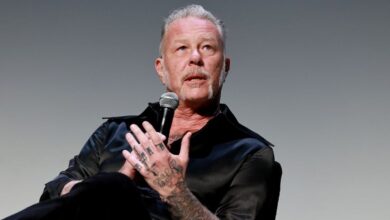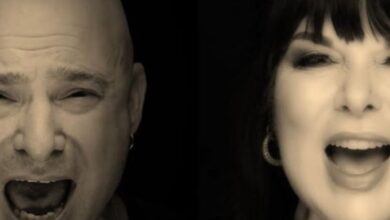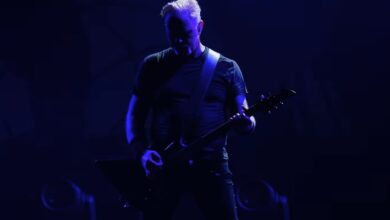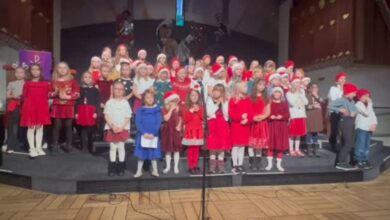When Metal Met Pop: Lady Gaga and Metallica’s Unstoppable Grammy Collision
There are performances that electrify a crowd, some that burn themselves into memory, and then there are a select few that make music history feel alive in real time. The 59th Annual Grammy Awards gave us one of those rare collisions—a meeting point for rock and pop that nobody expected, but everyone would remember. In 2017, the Staples Center’s stage was transformed into a spectacle where Metallica’s James Hetfield and pop icon Lady Gaga joined forces for an unforgettable performance of “Moth Into Flame.” The venue was buzzing, genres were on edge, and what unfolded next was pure, unfiltered brilliance.
Before the show, the thought of Metallica—standard bearers for heavy metal, known for thunderous riffs and raw, uncompromising vocals—joining forces with Lady Gaga, the queen of pop spectacle, seemed like a risky experiment. But when the lights dropped and the two acts took the stage, it became clear that this wasn’t about differences—it was about mutual respect and explosive energy. It was as if the spirit of collaboration took physical form, and something undeniably new was about to unfold.
The opening riff thundered across the arena as Gaga, clad in black leather and spikes, matched the band’s attitude with her own theatrical edge. She moved with the confidence of someone born for the stage, but there was a new grit to her performance. Hetfield, guitar slung low, brought his trademark presence—intense, fierce, and magnetic. With the crowd surging, the line between genres blurred into nothing.
Disaster struck in the opening lines: Hetfield’s microphone went dead. For an agonizing moment, his vocals were lost to the live broadcast, millions unable to hear the frontman’s signature roar. But where some might have faltered, Gaga’s instinct kicked in. Without hesitation, she offered her mic to Hetfield, seamlessly blending their voices and ramping up the adrenaline. The technical glitch didn’t slow them down—it made them even more unstoppable.
Rather than derail the performance, the glitch fueled the fire. Gaga’s vocals soared, her powerhouse range proving that pop stars can summon every ounce of rock’s grit and attitude when the moment calls for it. She met the challenge head-on, matching Metallica’s energy step for step, her voice cutting through the chaos with a bold, electrifying edge. Her stage presence was both theatrical and raw—her respect for the metal genre unmistakable.
Hetfield, initially frustrated by the technical mishap, turned that energy into a performance even more powerful. He shredded his guitar with renewed intensity, stalking the stage as if every note was a battle cry. As his vocals came back, he unleashed them with even more fury, determined to make up for lost time. The audience, once focused on the mic issue, now found themselves swept away by the pure synergy between these two titans.
The staging was relentless—blinding lights, fire, and relentless drum beats filled the arena. Lars Ulrich hammered out the rhythm with primal force, while Kirk Hammett’s guitar solo sliced through the sound like lightning. Gaga, completely at home among the chaos, danced alongside the band, embodying the role of a rock goddess with every move.
In the aftermath, critics praised not just the gutsiness of the performance but its significance. It wasn’t just a one-off show—it was a demolition of boundaries. Metal fans welcomed Gaga into their fold. Pop fans got a taste of Metallica’s relentless drive. For one night, the walls between genres crumbled, and everyone in the Staples Center sang along to a song that, on paper, should never have been a crossover moment.
Behind the scenes, both Hetfield and Gaga admitted their disappointment at the microphone glitch, but neither let it diminish the power of what they had created. Instead, the mishap became legend—proof that in live music, anything can happen and true professionals adapt in the moment. What could have been a disaster became a story of perseverance and creative chemistry, cementing its place as the most memorable moment of the evening.
The internet exploded with reactions. Photos of Hetfield and Gaga sharing a mic became instant memes, their unlikely partnership inspiring gifs, remixes, and viral videos. Fans began to imagine what a full Gaga x Metallica album would sound like, and the live video quickly racked up millions of views. For weeks, social feeds lit up with praise, debate, and admiration for the fearless collaboration.
Gaga herself would later reflect that sharing the stage with Metallica was one of the most electrifying experiences of her life. She spoke with reverence about the band’s history, but also about her determination to show she could thrive outside her own genre. That performance was a testament to the idea that pop and metal, far from being opposites, share a heart—passion, showmanship, and a hunger to move crowds.
As for Metallica, the night marked a bold new chapter. Always known for pushing the envelope, they now found their music resonating with a whole new audience. Young pop fans, many of whom had never ventured into metal before, started exploring Metallica’s catalog, discovering the band’s legacy of innovation and energy.
Years have passed, but the performance endures as one of the Grammys’ most celebrated moments—not just for the technical fireworks, or the dramatic mishap, but for the authenticity and daring on display. The moment stands as proof that when musicians take risks and pour their hearts into their craft, the results can be transformative and unforgettable.
In the end, the wild, chaotic energy of that Grammy night left audiences with one clear message: when talent and courage collide, genres dissolve and only the power of music remains. That single, defiant performance did more than unite two musical worlds—it reminded everyone watching why live music is a force like no other.
